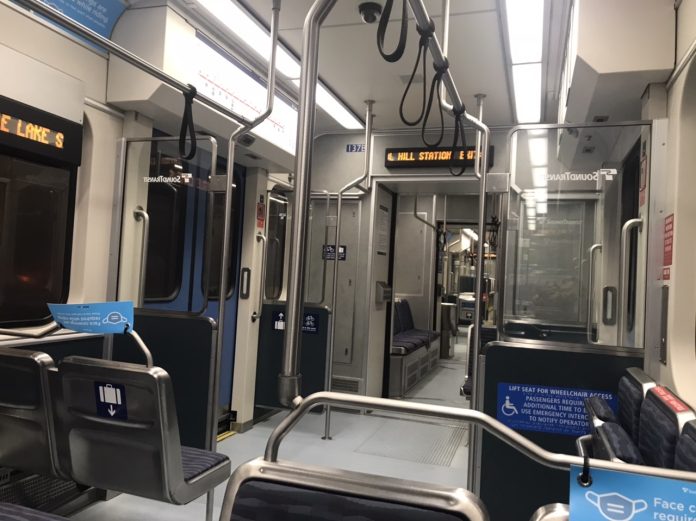Sound Transit is running up against staffing challenges due to the pandemic, which has led the agency to temporarily cut back light rail and streetcar service. On Friday, the agency issued an advisory notice that Central Link service, operated by King County Metro, would be cut at weekday peak times from every eight minutes to weekday off-peak frequencies of every 12 minutes. The service cutbacks go into effect on Monday, December 7th with no timeline for restoration of higher service levels. For similar reasons announced on Wednesday, Tacoma Link service, operated directly by Sound Transit, is being cut back on Saturday, December 5th (today) and Saturday, December 12th to operate on Sunday service. This means 24-minute frequencies instead of 12-minute frequencies and a much shorter span of service.
“Sound Transit was recently informed by King County Metro, which operates and maintains Link service under contract, that numerous factors relating to the COVID pandemic are triggering a shortage of operators to operate the service at current frequencies,” the advisory said. “Operator shortages were also a challenge when COVID rates spiked back in March.”
Metro disclosed last week that the number of employees infected by COVID has been rising swiftly. Twenty-one employees had been known to have contracted the disease over a 30-day period from October 23rd to November 21st, representing about 0.4% of the agency’s workforce. However, by November 25th the total number of reported cases by employees was 61 since March–an eight month period–which means that the average monthly period saw confirmed infections of about five staff members prior to October 23rd.
Service from Metro is highly susceptible to reductions when staff become sick. While there are some staffing redundancies, in normal times individual bus trips, for instance, can wind up canceled if a staff member has to call out sick. The pandemic has made this much more of a challenge, especially because the agency rightly has a strict COVID-safe policy to keep sick staff at home to stem spread of the disease. So it is no surprise that in a time where cases are quickly spread internally within the agency and local communities at large that this could become an operational problem.
On top of this, Metro cannot simply reallocate redundant bus operators to become rail operators. There are many technical differences between how these vehicles operating, requiring extensive training to obtain the skills necessary to operate them. Training to become a Link operator is months in the making. But it does to call into question whether cross-training operators may be a useful and possible thing for extraordinary times like now to avoid reductions on the region’s most critical services like Central Link.
The recently approved biennial budget could create some other intermediate future challenges and opportunities ahead as Metro changes staffing levels. The budget has called for a net reduction of 337 full-time equivalent positions in bus operations, including operator, mechanic, and maintenance classifications for the biennium. Many of those cuts have been realized as Metro reduced service this year by eliminating about 200 part-time operators, representing 120 full-time equivalent positions. Other operations cutbacks will largely be achieved through voluntary departures and eliminating vacant positions. Meanwhile, the biennial budget will create about 181 new full-time equivalent positions in the rail division to support the Northgate light rail expansion later in 2021. Many of the positions will be dedicated to direct light rail service operations.
Riders should take note that trip planning apps like Transit, OneBusAway, and Google Maps may not capture the schedule changes. So assumed trip times could be off while the temporary service reductions are in place. Online agency timetables also do not appear to reflect the scheduled trip time changes yet.
Sound Transit warns that further service reductions or increases could occur on very short notice, largely at the whim of available staffing levels. It seems like riders will more likely than not need to be flexible in expecting further service reductions broadly across transit modes and agencies in the weeks and months ahead as the fall and winter bear on. Riders though also have a part to play in helping to protect service levels by following appropriate COVID protocols, such as staying home if sick, wearing face masks and social distancing as much as possible at all times while on transit, and skipping crowded buses and trains. The good times are unfortunately not yet here, but hopefully riders and transit providers will be able to make it through this season relatively unscathed given the circumstances.
Stephen is a professional urban planner in Puget Sound with a passion for sustainable, livable, and diverse cities. He is especially interested in how policies, regulations, and programs can promote positive outcomes for communities. With stints in great cities like Bellingham and Cork, Stephen currently lives in Seattle. He primarily covers land use and transportation issues and has been with The Urbanist since 2014.



